Analyzing Transfer of Care: A Case Study in Western Sydney
VerifiedAdded on 2023/06/05
|9
|2104
|201
Case Study
AI Summary
This case study analyzes the transfer of care for Joseph and Sophia Russo, a couple in Western Sydney facing health challenges. Joseph's incident with carbon monoxide poisoning and Sophia's COPD and heart failure necessitate a coordinated care approach. The analysis emphasizes person-centered care, evidence-based services, and strength-based nursing principles to improve their health and well-being. Ethical considerations, cultural sensitivity, and interdisciplinary collaboration are highlighted to ensure comprehensive support. The study concludes that a holistic approach, integrating community programs and addressing social interactions, is crucial for the Russo family's overall health. Desklib offers more solved assignments and study resources for students.
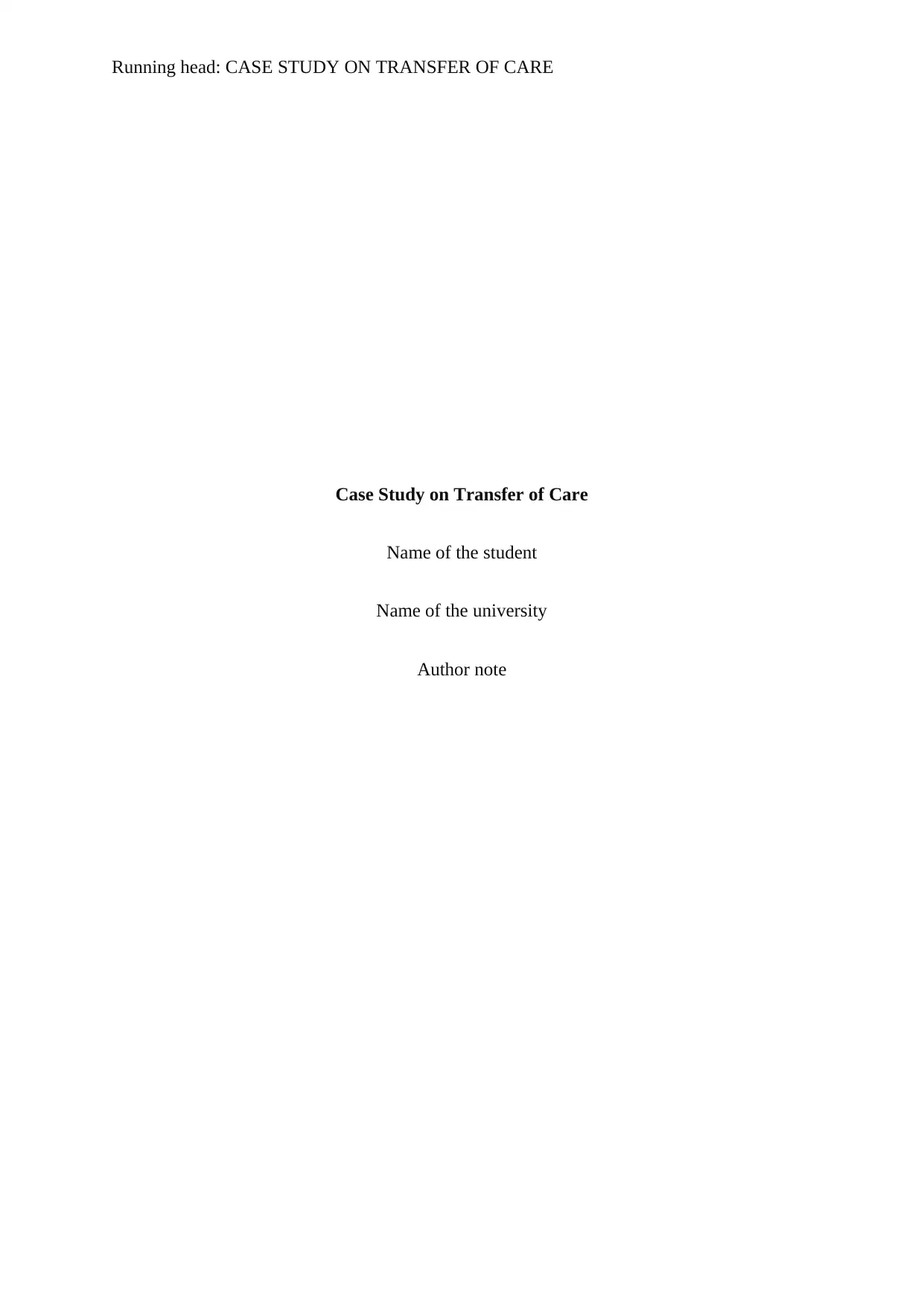
Running head: CASE STUDY ON TRANSFER OF CARE
Case Study on Transfer of Care
Name of the student
Name of the university
Author note
Case Study on Transfer of Care
Name of the student
Name of the university
Author note
Paraphrase This Document
Need a fresh take? Get an instant paraphrase of this document with our AI Paraphraser
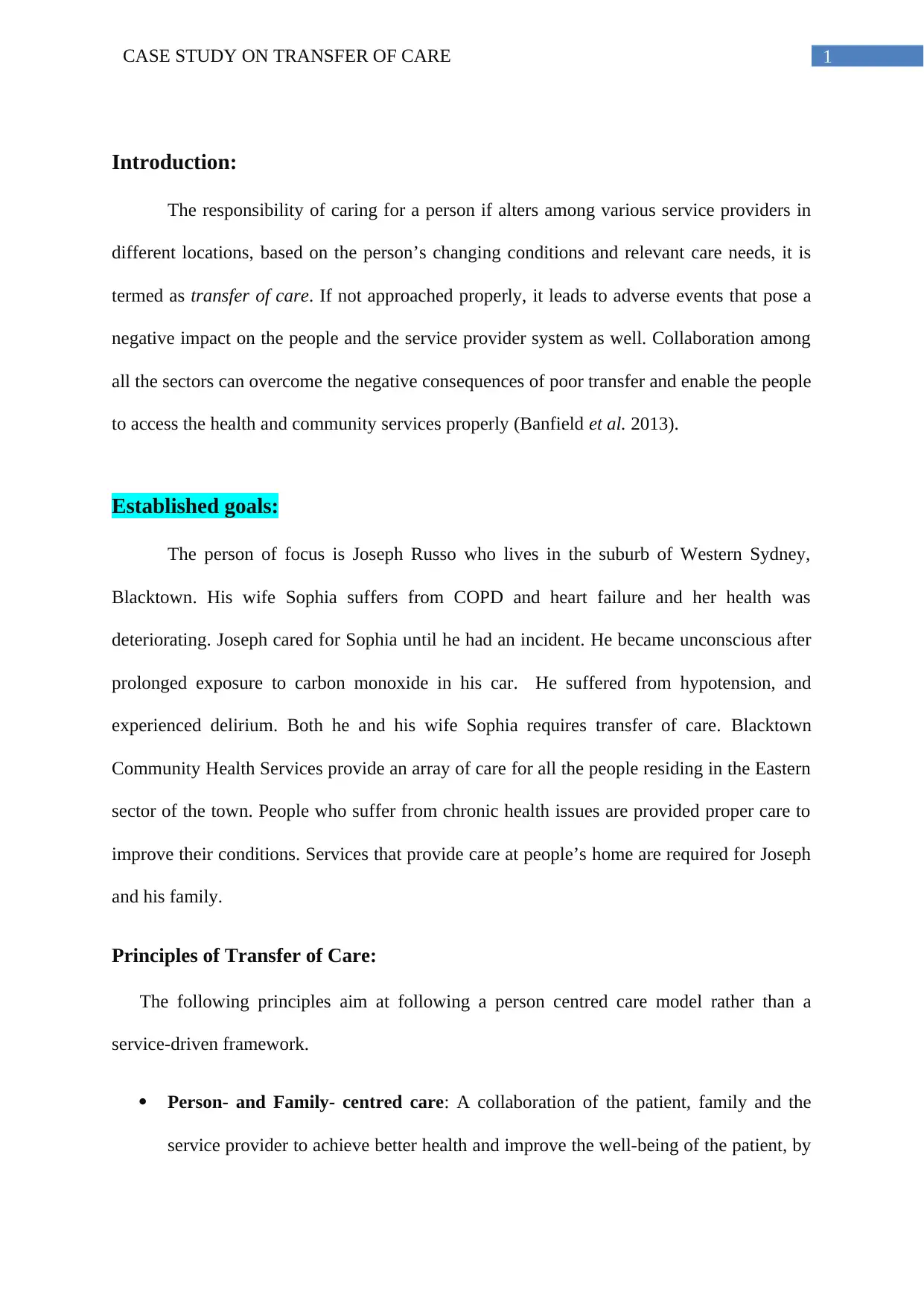
1CASE STUDY ON TRANSFER OF CARE
Introduction:
The responsibility of caring for a person if alters among various service providers in
different locations, based on the person’s changing conditions and relevant care needs, it is
termed as transfer of care. If not approached properly, it leads to adverse events that pose a
negative impact on the people and the service provider system as well. Collaboration among
all the sectors can overcome the negative consequences of poor transfer and enable the people
to access the health and community services properly (Banfield et al. 2013).
Established goals:
The person of focus is Joseph Russo who lives in the suburb of Western Sydney,
Blacktown. His wife Sophia suffers from COPD and heart failure and her health was
deteriorating. Joseph cared for Sophia until he had an incident. He became unconscious after
prolonged exposure to carbon monoxide in his car. He suffered from hypotension, and
experienced delirium. Both he and his wife Sophia requires transfer of care. Blacktown
Community Health Services provide an array of care for all the people residing in the Eastern
sector of the town. People who suffer from chronic health issues are provided proper care to
improve their conditions. Services that provide care at people’s home are required for Joseph
and his family.
Principles of Transfer of Care:
The following principles aim at following a person centred care model rather than a
service-driven framework.
Person- and Family- centred care: A collaboration of the patient, family and the
service provider to achieve better health and improve the well-being of the patient, by
Introduction:
The responsibility of caring for a person if alters among various service providers in
different locations, based on the person’s changing conditions and relevant care needs, it is
termed as transfer of care. If not approached properly, it leads to adverse events that pose a
negative impact on the people and the service provider system as well. Collaboration among
all the sectors can overcome the negative consequences of poor transfer and enable the people
to access the health and community services properly (Banfield et al. 2013).
Established goals:
The person of focus is Joseph Russo who lives in the suburb of Western Sydney,
Blacktown. His wife Sophia suffers from COPD and heart failure and her health was
deteriorating. Joseph cared for Sophia until he had an incident. He became unconscious after
prolonged exposure to carbon monoxide in his car. He suffered from hypotension, and
experienced delirium. Both he and his wife Sophia requires transfer of care. Blacktown
Community Health Services provide an array of care for all the people residing in the Eastern
sector of the town. People who suffer from chronic health issues are provided proper care to
improve their conditions. Services that provide care at people’s home are required for Joseph
and his family.
Principles of Transfer of Care:
The following principles aim at following a person centred care model rather than a
service-driven framework.
Person- and Family- centred care: A collaboration of the patient, family and the
service provider to achieve better health and improve the well-being of the patient, by
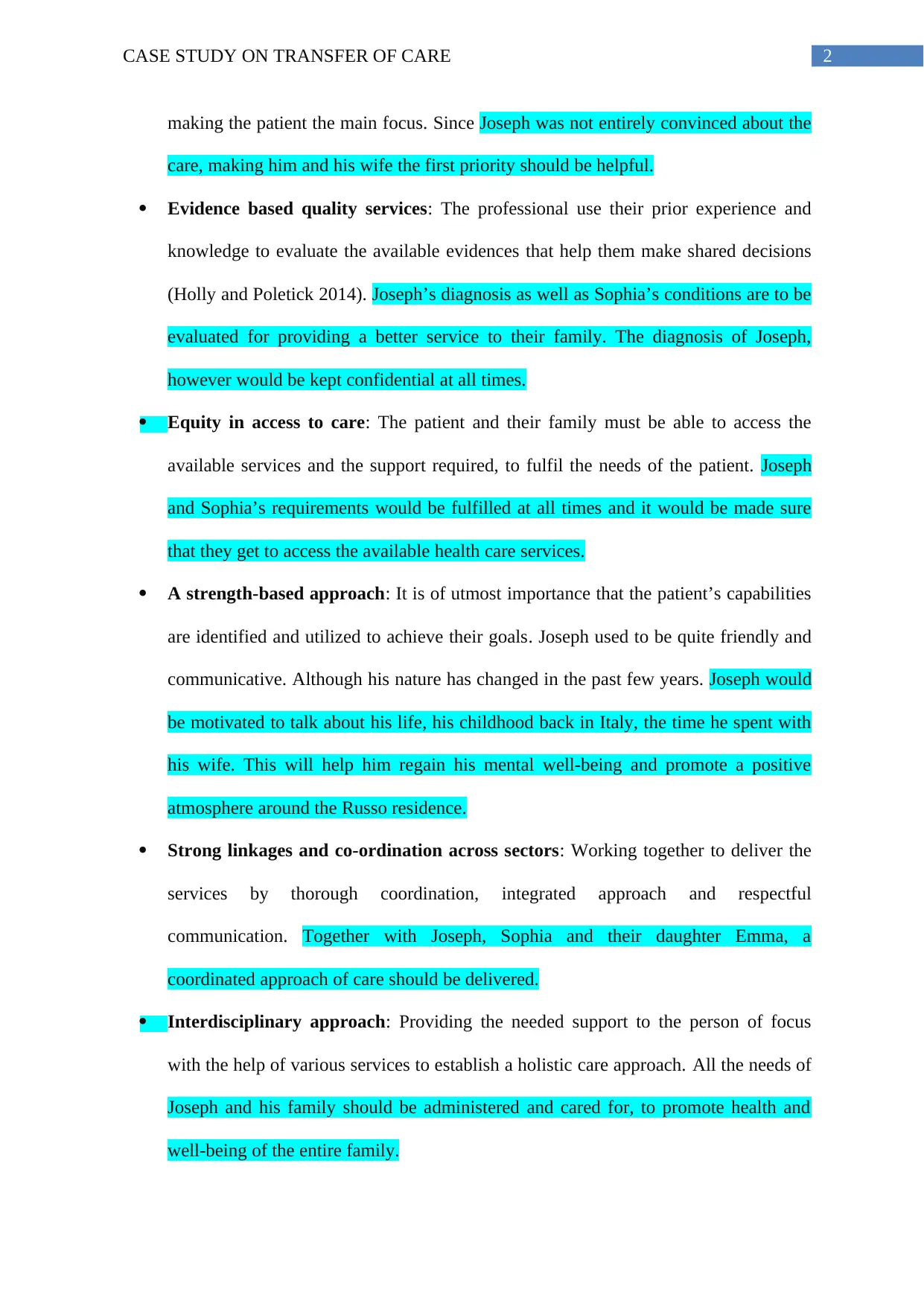
2CASE STUDY ON TRANSFER OF CARE
making the patient the main focus. Since Joseph was not entirely convinced about the
care, making him and his wife the first priority should be helpful.
Evidence based quality services: The professional use their prior experience and
knowledge to evaluate the available evidences that help them make shared decisions
(Holly and Poletick 2014). Joseph’s diagnosis as well as Sophia’s conditions are to be
evaluated for providing a better service to their family. The diagnosis of Joseph,
however would be kept confidential at all times.
Equity in access to care: The patient and their family must be able to access the
available services and the support required, to fulfil the needs of the patient. Joseph
and Sophia’s requirements would be fulfilled at all times and it would be made sure
that they get to access the available health care services.
A strength-based approach: It is of utmost importance that the patient’s capabilities
are identified and utilized to achieve their goals. Joseph used to be quite friendly and
communicative. Although his nature has changed in the past few years. Joseph would
be motivated to talk about his life, his childhood back in Italy, the time he spent with
his wife. This will help him regain his mental well-being and promote a positive
atmosphere around the Russo residence.
Strong linkages and co-ordination across sectors: Working together to deliver the
services by thorough coordination, integrated approach and respectful
communication. Together with Joseph, Sophia and their daughter Emma, a
coordinated approach of care should be delivered.
Interdisciplinary approach: Providing the needed support to the person of focus
with the help of various services to establish a holistic care approach. All the needs of
Joseph and his family should be administered and cared for, to promote health and
well-being of the entire family.
making the patient the main focus. Since Joseph was not entirely convinced about the
care, making him and his wife the first priority should be helpful.
Evidence based quality services: The professional use their prior experience and
knowledge to evaluate the available evidences that help them make shared decisions
(Holly and Poletick 2014). Joseph’s diagnosis as well as Sophia’s conditions are to be
evaluated for providing a better service to their family. The diagnosis of Joseph,
however would be kept confidential at all times.
Equity in access to care: The patient and their family must be able to access the
available services and the support required, to fulfil the needs of the patient. Joseph
and Sophia’s requirements would be fulfilled at all times and it would be made sure
that they get to access the available health care services.
A strength-based approach: It is of utmost importance that the patient’s capabilities
are identified and utilized to achieve their goals. Joseph used to be quite friendly and
communicative. Although his nature has changed in the past few years. Joseph would
be motivated to talk about his life, his childhood back in Italy, the time he spent with
his wife. This will help him regain his mental well-being and promote a positive
atmosphere around the Russo residence.
Strong linkages and co-ordination across sectors: Working together to deliver the
services by thorough coordination, integrated approach and respectful
communication. Together with Joseph, Sophia and their daughter Emma, a
coordinated approach of care should be delivered.
Interdisciplinary approach: Providing the needed support to the person of focus
with the help of various services to establish a holistic care approach. All the needs of
Joseph and his family should be administered and cared for, to promote health and
well-being of the entire family.
⊘ This is a preview!⊘
Do you want full access?
Subscribe today to unlock all pages.

Trusted by 1+ million students worldwide
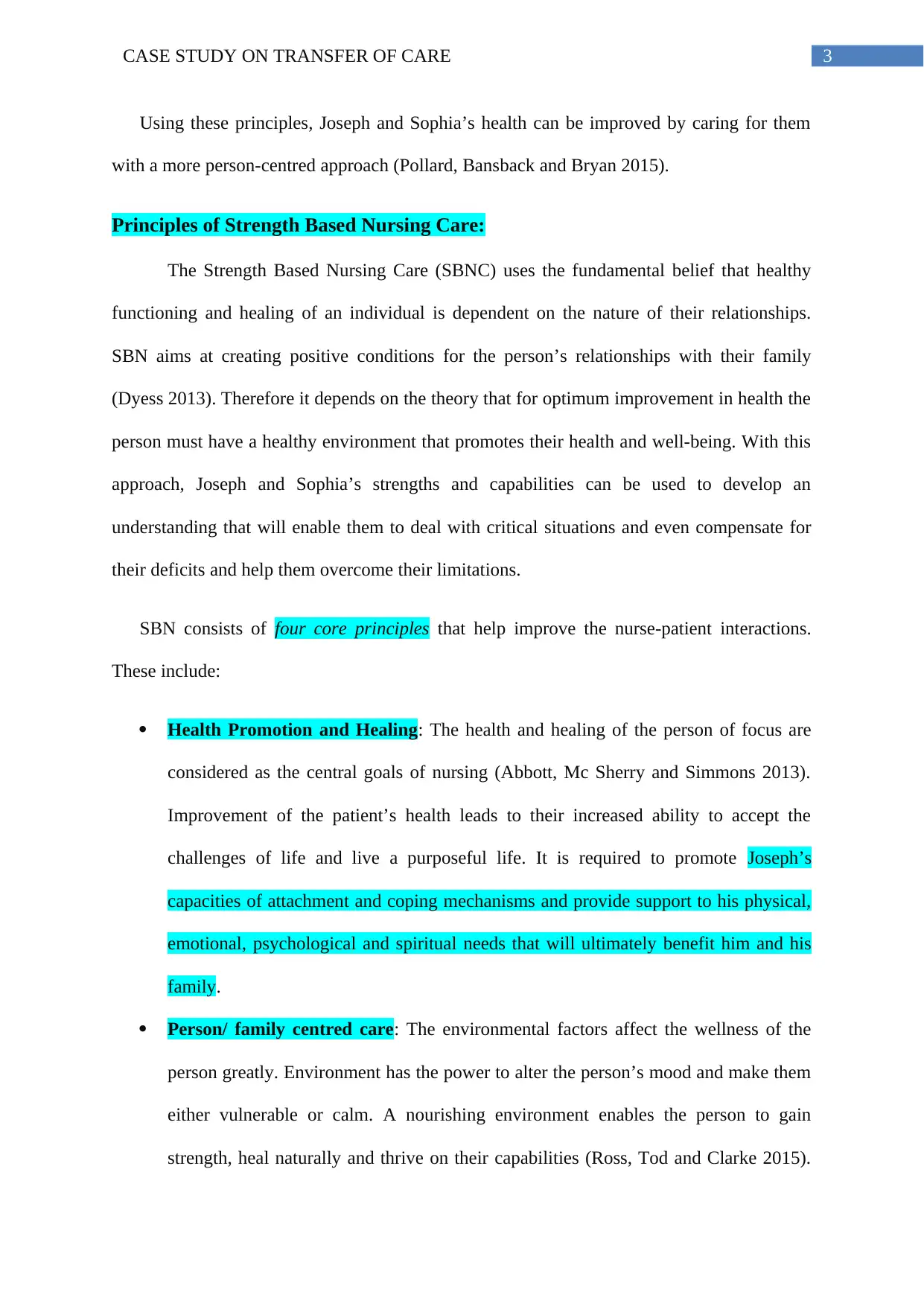
3CASE STUDY ON TRANSFER OF CARE
Using these principles, Joseph and Sophia’s health can be improved by caring for them
with a more person-centred approach (Pollard, Bansback and Bryan 2015).
Principles of Strength Based Nursing Care:
The Strength Based Nursing Care (SBNC) uses the fundamental belief that healthy
functioning and healing of an individual is dependent on the nature of their relationships.
SBN aims at creating positive conditions for the person’s relationships with their family
(Dyess 2013). Therefore it depends on the theory that for optimum improvement in health the
person must have a healthy environment that promotes their health and well-being. With this
approach, Joseph and Sophia’s strengths and capabilities can be used to develop an
understanding that will enable them to deal with critical situations and even compensate for
their deficits and help them overcome their limitations.
SBN consists of four core principles that help improve the nurse-patient interactions.
These include:
Health Promotion and Healing: The health and healing of the person of focus are
considered as the central goals of nursing (Abbott, Mc Sherry and Simmons 2013).
Improvement of the patient’s health leads to their increased ability to accept the
challenges of life and live a purposeful life. It is required to promote Joseph’s
capacities of attachment and coping mechanisms and provide support to his physical,
emotional, psychological and spiritual needs that will ultimately benefit him and his
family.
Person/ family centred care: The environmental factors affect the wellness of the
person greatly. Environment has the power to alter the person’s mood and make them
either vulnerable or calm. A nourishing environment enables the person to gain
strength, heal naturally and thrive on their capabilities (Ross, Tod and Clarke 2015).
Using these principles, Joseph and Sophia’s health can be improved by caring for them
with a more person-centred approach (Pollard, Bansback and Bryan 2015).
Principles of Strength Based Nursing Care:
The Strength Based Nursing Care (SBNC) uses the fundamental belief that healthy
functioning and healing of an individual is dependent on the nature of their relationships.
SBN aims at creating positive conditions for the person’s relationships with their family
(Dyess 2013). Therefore it depends on the theory that for optimum improvement in health the
person must have a healthy environment that promotes their health and well-being. With this
approach, Joseph and Sophia’s strengths and capabilities can be used to develop an
understanding that will enable them to deal with critical situations and even compensate for
their deficits and help them overcome their limitations.
SBN consists of four core principles that help improve the nurse-patient interactions.
These include:
Health Promotion and Healing: The health and healing of the person of focus are
considered as the central goals of nursing (Abbott, Mc Sherry and Simmons 2013).
Improvement of the patient’s health leads to their increased ability to accept the
challenges of life and live a purposeful life. It is required to promote Joseph’s
capacities of attachment and coping mechanisms and provide support to his physical,
emotional, psychological and spiritual needs that will ultimately benefit him and his
family.
Person/ family centred care: The environmental factors affect the wellness of the
person greatly. Environment has the power to alter the person’s mood and make them
either vulnerable or calm. A nourishing environment enables the person to gain
strength, heal naturally and thrive on their capabilities (Ross, Tod and Clarke 2015).
Paraphrase This Document
Need a fresh take? Get an instant paraphrase of this document with our AI Paraphraser
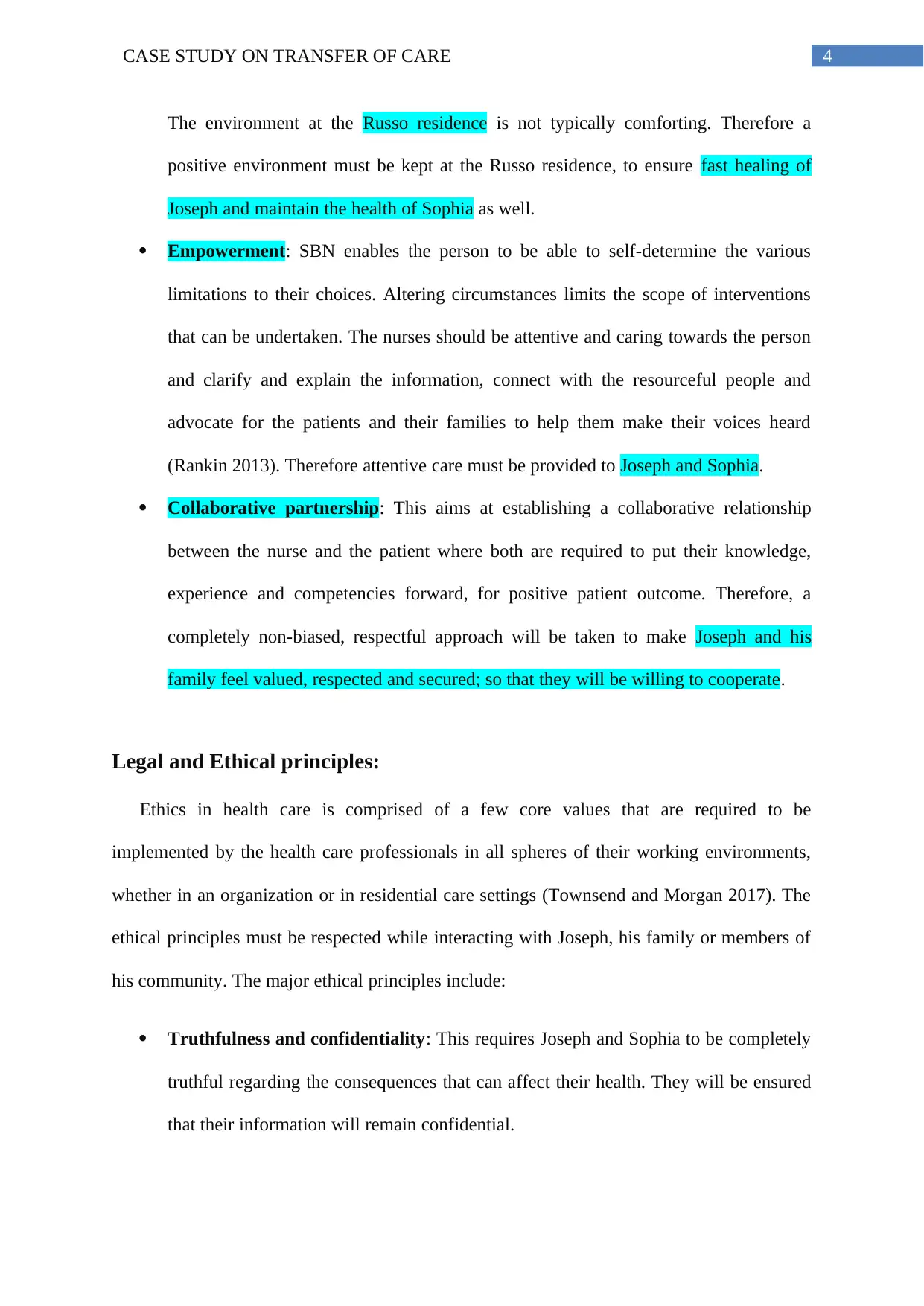
4CASE STUDY ON TRANSFER OF CARE
The environment at the Russo residence is not typically comforting. Therefore a
positive environment must be kept at the Russo residence, to ensure fast healing of
Joseph and maintain the health of Sophia as well.
Empowerment: SBN enables the person to be able to self-determine the various
limitations to their choices. Altering circumstances limits the scope of interventions
that can be undertaken. The nurses should be attentive and caring towards the person
and clarify and explain the information, connect with the resourceful people and
advocate for the patients and their families to help them make their voices heard
(Rankin 2013). Therefore attentive care must be provided to Joseph and Sophia.
Collaborative partnership: This aims at establishing a collaborative relationship
between the nurse and the patient where both are required to put their knowledge,
experience and competencies forward, for positive patient outcome. Therefore, a
completely non-biased, respectful approach will be taken to make Joseph and his
family feel valued, respected and secured; so that they will be willing to cooperate.
Legal and Ethical principles:
Ethics in health care is comprised of a few core values that are required to be
implemented by the health care professionals in all spheres of their working environments,
whether in an organization or in residential care settings (Townsend and Morgan 2017). The
ethical principles must be respected while interacting with Joseph, his family or members of
his community. The major ethical principles include:
Truthfulness and confidentiality: This requires Joseph and Sophia to be completely
truthful regarding the consequences that can affect their health. They will be ensured
that their information will remain confidential.
The environment at the Russo residence is not typically comforting. Therefore a
positive environment must be kept at the Russo residence, to ensure fast healing of
Joseph and maintain the health of Sophia as well.
Empowerment: SBN enables the person to be able to self-determine the various
limitations to their choices. Altering circumstances limits the scope of interventions
that can be undertaken. The nurses should be attentive and caring towards the person
and clarify and explain the information, connect with the resourceful people and
advocate for the patients and their families to help them make their voices heard
(Rankin 2013). Therefore attentive care must be provided to Joseph and Sophia.
Collaborative partnership: This aims at establishing a collaborative relationship
between the nurse and the patient where both are required to put their knowledge,
experience and competencies forward, for positive patient outcome. Therefore, a
completely non-biased, respectful approach will be taken to make Joseph and his
family feel valued, respected and secured; so that they will be willing to cooperate.
Legal and Ethical principles:
Ethics in health care is comprised of a few core values that are required to be
implemented by the health care professionals in all spheres of their working environments,
whether in an organization or in residential care settings (Townsend and Morgan 2017). The
ethical principles must be respected while interacting with Joseph, his family or members of
his community. The major ethical principles include:
Truthfulness and confidentiality: This requires Joseph and Sophia to be completely
truthful regarding the consequences that can affect their health. They will be ensured
that their information will remain confidential.
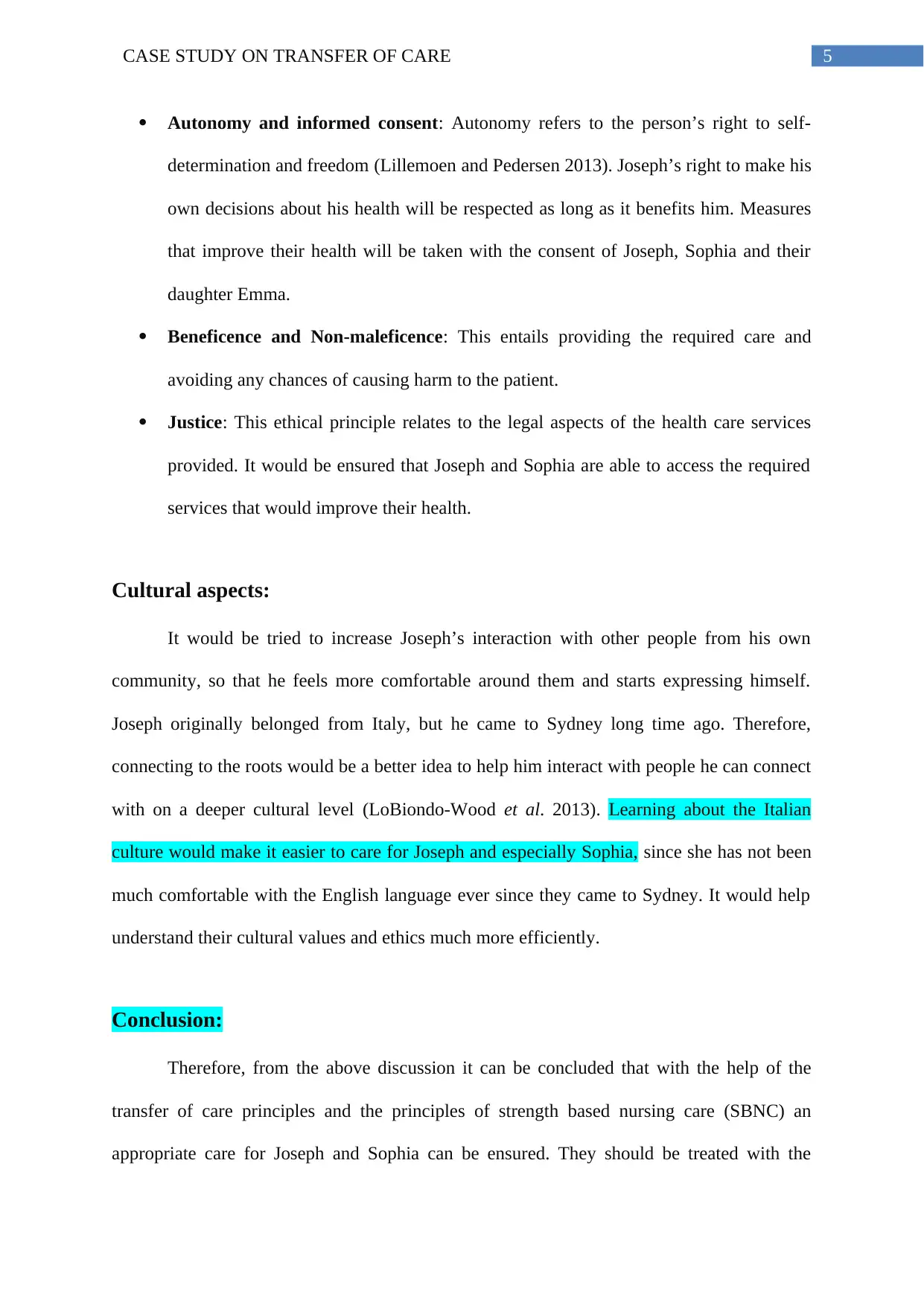
5CASE STUDY ON TRANSFER OF CARE
Autonomy and informed consent: Autonomy refers to the person’s right to self-
determination and freedom (Lillemoen and Pedersen 2013). Joseph’s right to make his
own decisions about his health will be respected as long as it benefits him. Measures
that improve their health will be taken with the consent of Joseph, Sophia and their
daughter Emma.
Beneficence and Non-maleficence: This entails providing the required care and
avoiding any chances of causing harm to the patient.
Justice: This ethical principle relates to the legal aspects of the health care services
provided. It would be ensured that Joseph and Sophia are able to access the required
services that would improve their health.
Cultural aspects:
It would be tried to increase Joseph’s interaction with other people from his own
community, so that he feels more comfortable around them and starts expressing himself.
Joseph originally belonged from Italy, but he came to Sydney long time ago. Therefore,
connecting to the roots would be a better idea to help him interact with people he can connect
with on a deeper cultural level (LoBiondo-Wood et al. 2013). Learning about the Italian
culture would make it easier to care for Joseph and especially Sophia, since she has not been
much comfortable with the English language ever since they came to Sydney. It would help
understand their cultural values and ethics much more efficiently.
Conclusion:
Therefore, from the above discussion it can be concluded that with the help of the
transfer of care principles and the principles of strength based nursing care (SBNC) an
appropriate care for Joseph and Sophia can be ensured. They should be treated with the
Autonomy and informed consent: Autonomy refers to the person’s right to self-
determination and freedom (Lillemoen and Pedersen 2013). Joseph’s right to make his
own decisions about his health will be respected as long as it benefits him. Measures
that improve their health will be taken with the consent of Joseph, Sophia and their
daughter Emma.
Beneficence and Non-maleficence: This entails providing the required care and
avoiding any chances of causing harm to the patient.
Justice: This ethical principle relates to the legal aspects of the health care services
provided. It would be ensured that Joseph and Sophia are able to access the required
services that would improve their health.
Cultural aspects:
It would be tried to increase Joseph’s interaction with other people from his own
community, so that he feels more comfortable around them and starts expressing himself.
Joseph originally belonged from Italy, but he came to Sydney long time ago. Therefore,
connecting to the roots would be a better idea to help him interact with people he can connect
with on a deeper cultural level (LoBiondo-Wood et al. 2013). Learning about the Italian
culture would make it easier to care for Joseph and especially Sophia, since she has not been
much comfortable with the English language ever since they came to Sydney. It would help
understand their cultural values and ethics much more efficiently.
Conclusion:
Therefore, from the above discussion it can be concluded that with the help of the
transfer of care principles and the principles of strength based nursing care (SBNC) an
appropriate care for Joseph and Sophia can be ensured. They should be treated with the
⊘ This is a preview!⊘
Do you want full access?
Subscribe today to unlock all pages.

Trusted by 1+ million students worldwide
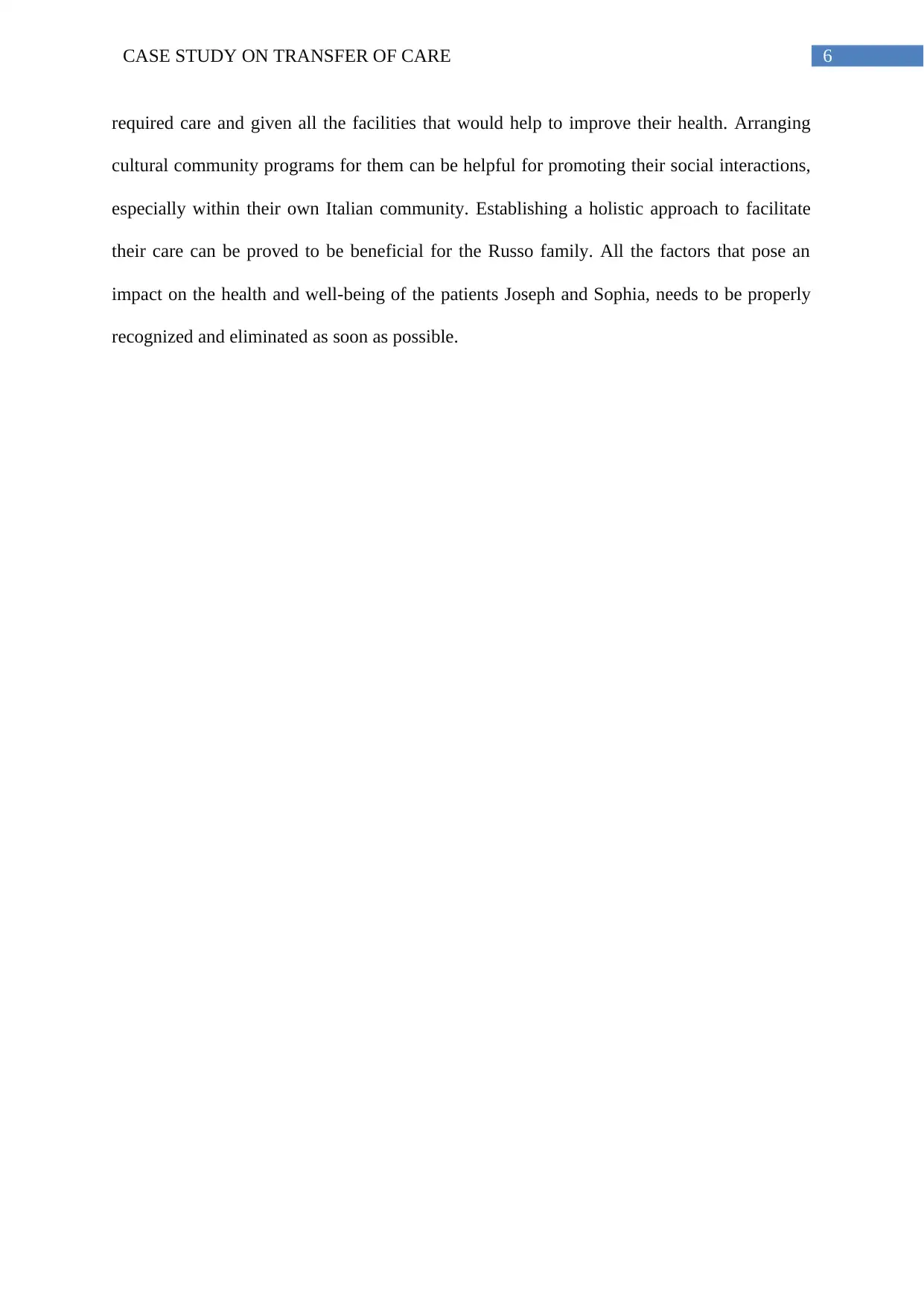
6CASE STUDY ON TRANSFER OF CARE
required care and given all the facilities that would help to improve their health. Arranging
cultural community programs for them can be helpful for promoting their social interactions,
especially within their own Italian community. Establishing a holistic approach to facilitate
their care can be proved to be beneficial for the Russo family. All the factors that pose an
impact on the health and well-being of the patients Joseph and Sophia, needs to be properly
recognized and eliminated as soon as possible.
required care and given all the facilities that would help to improve their health. Arranging
cultural community programs for them can be helpful for promoting their social interactions,
especially within their own Italian community. Establishing a holistic approach to facilitate
their care can be proved to be beneficial for the Russo family. All the factors that pose an
impact on the health and well-being of the patients Joseph and Sophia, needs to be properly
recognized and eliminated as soon as possible.
Paraphrase This Document
Need a fresh take? Get an instant paraphrase of this document with our AI Paraphraser
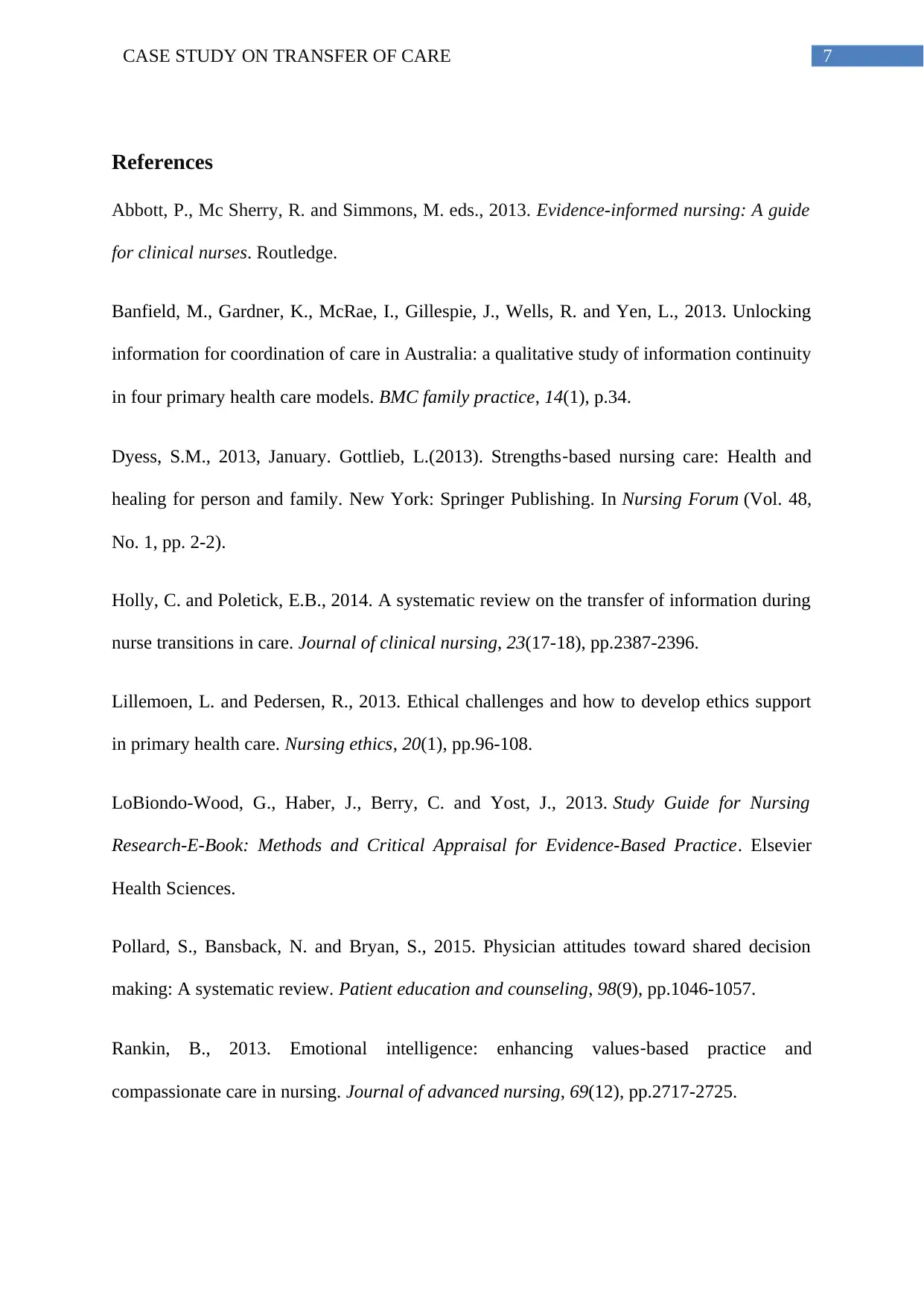
7CASE STUDY ON TRANSFER OF CARE
References
Abbott, P., Mc Sherry, R. and Simmons, M. eds., 2013. Evidence-informed nursing: A guide
for clinical nurses. Routledge.
Banfield, M., Gardner, K., McRae, I., Gillespie, J., Wells, R. and Yen, L., 2013. Unlocking
information for coordination of care in Australia: a qualitative study of information continuity
in four primary health care models. BMC family practice, 14(1), p.34.
Dyess, S.M., 2013, January. Gottlieb, L.(2013). Strengths‐based nursing care: Health and
healing for person and family. New York: Springer Publishing. In Nursing Forum (Vol. 48,
No. 1, pp. 2-2).
Holly, C. and Poletick, E.B., 2014. A systematic review on the transfer of information during
nurse transitions in care. Journal of clinical nursing, 23(17-18), pp.2387-2396.
Lillemoen, L. and Pedersen, R., 2013. Ethical challenges and how to develop ethics support
in primary health care. Nursing ethics, 20(1), pp.96-108.
LoBiondo-Wood, G., Haber, J., Berry, C. and Yost, J., 2013. Study Guide for Nursing
Research-E-Book: Methods and Critical Appraisal for Evidence-Based Practice. Elsevier
Health Sciences.
Pollard, S., Bansback, N. and Bryan, S., 2015. Physician attitudes toward shared decision
making: A systematic review. Patient education and counseling, 98(9), pp.1046-1057.
Rankin, B., 2013. Emotional intelligence: enhancing values‐based practice and
compassionate care in nursing. Journal of advanced nursing, 69(12), pp.2717-2725.
References
Abbott, P., Mc Sherry, R. and Simmons, M. eds., 2013. Evidence-informed nursing: A guide
for clinical nurses. Routledge.
Banfield, M., Gardner, K., McRae, I., Gillespie, J., Wells, R. and Yen, L., 2013. Unlocking
information for coordination of care in Australia: a qualitative study of information continuity
in four primary health care models. BMC family practice, 14(1), p.34.
Dyess, S.M., 2013, January. Gottlieb, L.(2013). Strengths‐based nursing care: Health and
healing for person and family. New York: Springer Publishing. In Nursing Forum (Vol. 48,
No. 1, pp. 2-2).
Holly, C. and Poletick, E.B., 2014. A systematic review on the transfer of information during
nurse transitions in care. Journal of clinical nursing, 23(17-18), pp.2387-2396.
Lillemoen, L. and Pedersen, R., 2013. Ethical challenges and how to develop ethics support
in primary health care. Nursing ethics, 20(1), pp.96-108.
LoBiondo-Wood, G., Haber, J., Berry, C. and Yost, J., 2013. Study Guide for Nursing
Research-E-Book: Methods and Critical Appraisal for Evidence-Based Practice. Elsevier
Health Sciences.
Pollard, S., Bansback, N. and Bryan, S., 2015. Physician attitudes toward shared decision
making: A systematic review. Patient education and counseling, 98(9), pp.1046-1057.
Rankin, B., 2013. Emotional intelligence: enhancing values‐based practice and
compassionate care in nursing. Journal of advanced nursing, 69(12), pp.2717-2725.
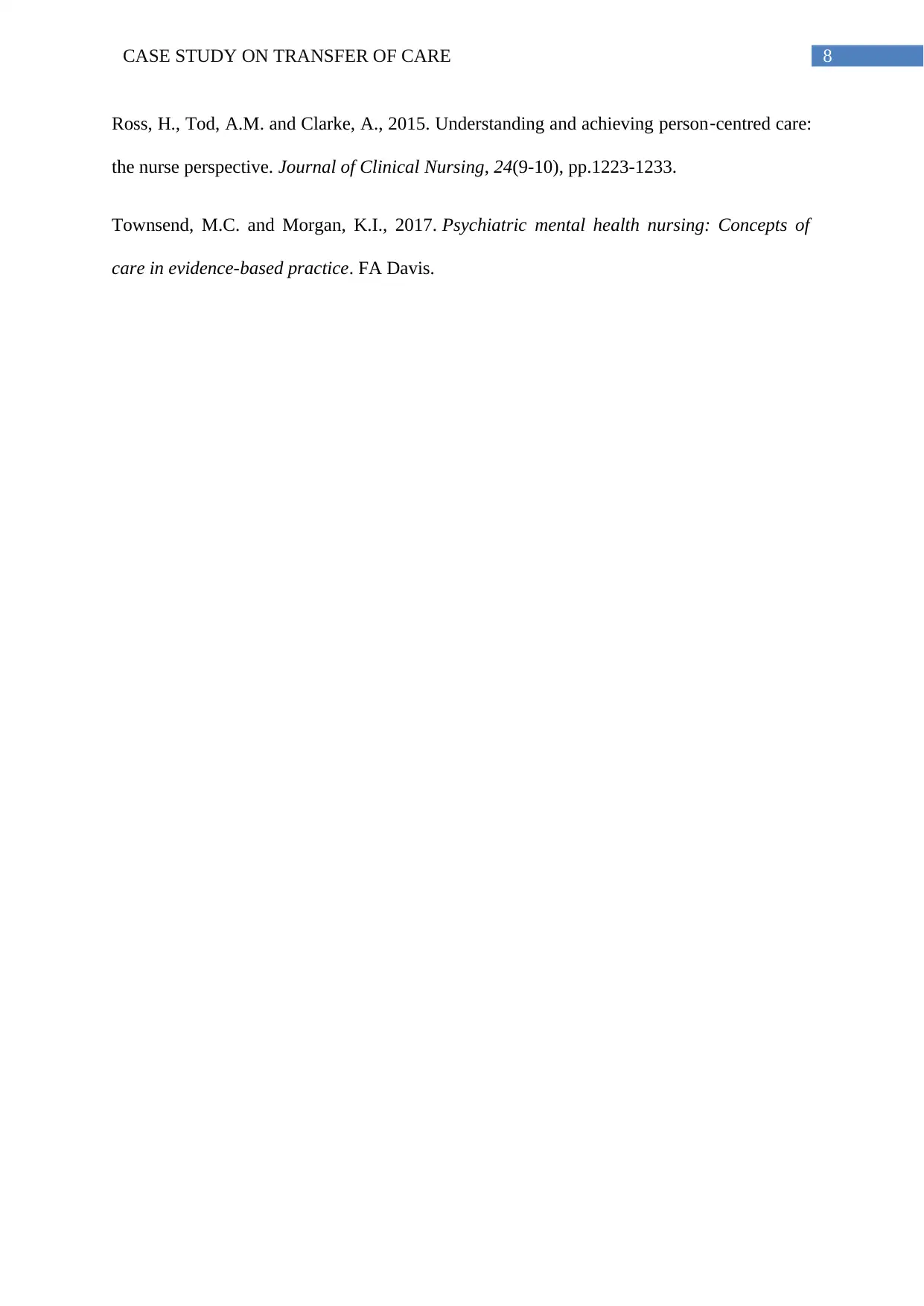
8CASE STUDY ON TRANSFER OF CARE
Ross, H., Tod, A.M. and Clarke, A., 2015. Understanding and achieving person‐centred care:
the nurse perspective. Journal of Clinical Nursing, 24(9-10), pp.1223-1233.
Townsend, M.C. and Morgan, K.I., 2017. Psychiatric mental health nursing: Concepts of
care in evidence-based practice. FA Davis.
Ross, H., Tod, A.M. and Clarke, A., 2015. Understanding and achieving person‐centred care:
the nurse perspective. Journal of Clinical Nursing, 24(9-10), pp.1223-1233.
Townsend, M.C. and Morgan, K.I., 2017. Psychiatric mental health nursing: Concepts of
care in evidence-based practice. FA Davis.
⊘ This is a preview!⊘
Do you want full access?
Subscribe today to unlock all pages.

Trusted by 1+ million students worldwide
1 out of 9
Related Documents
Your All-in-One AI-Powered Toolkit for Academic Success.
+13062052269
info@desklib.com
Available 24*7 on WhatsApp / Email
![[object Object]](/_next/static/media/star-bottom.7253800d.svg)
Unlock your academic potential
Copyright © 2020–2025 A2Z Services. All Rights Reserved. Developed and managed by ZUCOL.




